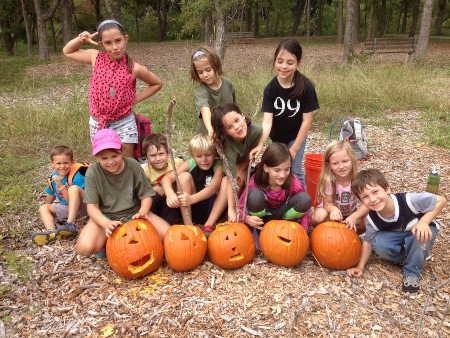Tips for outdoor exploration with young children
/Michelle Carbone is the youth programs coordinator and an instructor at Earth Native Wilderness School. She also contributes to the Kids in Nature Blog, where an earlier version of this post originally appeared. Thanks for sharing your expertise with Alt Ed Austin’s readers, Michelle!

It’s taken time for me to get used to some aspects of outdoor education. Teaching children to use knives and make fire, as well as hiking with preschoolers (we really are hiking, not just walking), have been some sources of apprehension. But each day, each moment I’m with these children, I not only realize anew how capable they are but also discover more ways to help ensure their safety.
Before the first tools, butter knives, were even handed out in a recent class, we discussed knife safety. We explained how knives are tools, not toys; that using knives is a privilege, not a right. We then spent a whole day practicing carving soap and apples with butter knives.

They all had to earn knife certification, where they proved to an instructor that not only could they regurgitate the information, but they could also explain what it meant to them in their own words, while demonstrating with a butter knife and a stick. Then they were able to use the fixed-blade steel knives. We gave them specific tasks, like carve the tip into a square, or remove all the bark. Soon they were ready to learn different skills, such as how to get rid of knots on the sides of sticks, or how to make a “flower” out of a stick.
I was with that same group of students in a later class, and they were carving pumpkins with knives—not the typical carving knife set you buy for $3.99 at Target, but real, stainless steel knives with a fixed blade. One of the children was celebrating his sixth birthday. It. Was. Amazing. The level of focus, care, and observance of safety rules was astounding.

We have a few basic rules at Earth Native; we call them the ABCs of carving, and the children follow them to a T. They even help one another, telling fellow students if they are too close to them while they are carving, or reminding others to carve away from themselves.
A couple of weeks ago, at the preschool program I teach, we went on a hike. It was probably half a mile—some uphill, some climbing over rocks, some down rocks. Before we came to a hill, I would warn them and suggest some options for safe travel. As they climbed, I commented on how they did, using positive reinforcement. I would say, “I like how (name) is using both their feet AND hands to get down the rocks,” or “Way to sit on your bottom and scoot down this slope!” And they did great. I also said that whenever we see poison ivy, we should turn to the person behind us, point to it, and say “Poison ivy, pass it on!” I’ve also called it “P.I.” in other classes, and the kids just love to point it out because it has a cool nickname.

To sum up, I recommend trying these ideas to help create safer and more positive outdoor explorations for you and your child:
- clear guidelines (especially with knives)
- options for success (different ways to climb up and down rocks)
- positive reinforcement (try to be specific with your comments)
- nature games (for example, Who can spot the most P.I.?)
Best of luck, and happy exploring!
Michelle Carbone









